With the 512 GB SSD, the laptop expands its storage capacity, letting you have more than 3-5 games installed at the same time. The aluminum housing will survive considerable knocks and even drops from low heights. The keyboard is great at registering keystrokes, improving the overall typing experience.
The laptop gets a little loud when the loads get high.
ASUS TUF 505GT shows that value gaming laptops can still tame the hottest titles, assuming that you're willing to pay a little extra. Apart from its military-grade housing, what defines this product is the excellent hardware, easily running most triple-A games at >60 fps.
15.6”, FHD (1920x1080), 120Hz, IPS
Processor: Intel® Core™ i7-9750H (Up to 4.5 GHz)
RAM: 8 GB
Memory: 512 GB SSD
Graphics card: NVIDIA GeForce GTX 1650 (4 GB)
Windows 10 Home
1 x HDMI, 3 x USB Type-A, 1 x LAN port, Mic and headphones combo jack
Up to 10 hours
14.2" x 10.3" x 1"
4.85 lbs
1 year
The Quick mode lets the laptop handle more demanding games, whereas the Quiet mode keeps the fans nice and quiet, enabling comfortable surfing and multimedia work. The Vantage Eye Care mode reduces the blue light output and adjusts the brightness, minimizing eye strain and fatigue.
Some find the speakers lacking.
Buying two separate machines for gaming and working is not something that most people can afford. That's where the Lenovo Ideapad L340 comes in. This laptop is as good at covering basic gaming needs as it is at aiding, facilitating, and streamlining productivity. With this bad boy, you'll be working hard and playing equally hard.
15.6”, FHD (1920x1080), 60Hz, IPS
Processor: Intel® Core™ i5-9300H (Up to 4.1 GHz)
RAM: 8 GB
Memory: 512 GB SSD
Graphics card: NVIDIA GeForce GTX 1650 (4 GB)
Windows 10 Home
1 x HDMI, 2 x USB Type-A, 1 x USB Type-C, 1 x LAN port, Mic and headphones combo jack
Up to 9 hours
14.3″ x 10″ x 0.9″
4.8 lbs
1 year
The DVD-RW drive will let you use CD and DVD discs, including writing and rewriting them, so you'll be able to play legacy games without even downloading them. The SD card slot will enable transferring photos from cameras. The touchpad is quite responsive.
The laptop's pretty heavy.
This HP laptop does not sit among the best value gaming systems, not quite. But, considering its 12 GB RAM setup, above-average CPU, and the 17.3-inch screen, the laptop will let you work and watch movies with more comfort than 15-inch displays can provide. Also, even though integrated, the GPU can run most games at low settings.
17.3”, HD+ (1600x900), 60Hz, SVA
Processor: AMD® Ryzen™ 5 3500U (Up to 3.7 GHz)
RAM: 12 GB
Memory: 256 GB SSD
Graphics card: AMD Radeon Vega 8 (integrated)
Windows 10 Home
1 x HDMI, 3 x USB Type-A, 1 x LAN port, Mic and headphones combo jack, Slot for SD cards, DVD-RW drive
Up to 8 hours
16.3" x 10.7" x 0.96"
5.56 lbs
1 year
The battery will usually last around 6-7 hours with you playing games non-stop and around 9-10 with you taking occasional breaks. The anti-dust cooling solution prevents the fans from gathering dust, so the laptop survives the heaviest loads without risking overheating.
The touchpad is not especially responsive.
When you have less than $800 but still feel like you deserve enjoying the most recent, most demanding games at ultra settings and high frame rates, the ASUS TUF FX505DT comes to the rescue. With this laptop, you can play these games without making any performance compromises.
15.6”, FHD (1920x1080), 120Hz, IPS
Processor: AMD® Ryzen™ 5 R5-3550H (Up to 3.7 GHz)
RAM: 8 GB
Memory: 256 GB SSD
Graphics card: NVIDIA GeForce GTX 1650 (4 GB)
Windows 10 Home
1 x HDMI, 3 x USB Type-A, 1 x LAN port, Mic and headphones combo jack
Up to 10 hours
14.2" x 10.3" x 1"
4.85 lbs
1 year
The laptop's solid-state drive will be booting Windows in 6 seconds tops. The IPS display will keep the colors accurate and the viewing angles wide. The Corning Gorilla Glass will make sure the screen resists scratches. Between the 4 USB ports, you can have two gadgets and two wired peripherals connected to the laptop simultaneously.
There's no LAN port.
Performance-wise, the Acer Swift 3 has its limitations, expecting anything different from $650 laptops is seldom smart. Still, assuming you're fine with basic HD (1280 x 720p), the laptop will hold its own against the most gluttonous games. Plus, it is the most compact and lightweight model on this list.
15.6”, FHD (1920x1080), 60Hz, IPS
Processor: AMD® Ryzen™ 7 2700U (Up to 3.8 GHz)
RAM: 8 GB
Memory: 256 GB SSD
Graphics card: AMD Radeon RX 540 (2 GB)
Windows 10 Home
1 x HDMI, 3 x USB Type-A, 1 x USB Type-C, Mic and headphones combo jack, Slot for SD cards
Up to 9 hours
14.56" x 10" x 0.74"
4.63 lbs
1 year
This site is a free online resource that strives to offer helpful content and comparison features to its visitors. Please be advised that the operator of this site accepts advertising compensation from certain companies that appear on the site, and such compensation impacts the location and order in which the companies (and/or their products) are presented, and in some cases may also impact the scoring that is assigned to them. The scoring that appears on this site is determined by the site operator in its sole discretion, and should NOT be relied upon for accuracy purposes. In fact, Company/product listings on this page DO NOT imply endorsement by the site operator. Except as expressly set forth in our Terms of Use, all representations and warranties regarding the information presented on this page are disclaimed. The information which appears on this site is subject to change at any time. More info
ASUS (TUF505GT-AH73)
Epitomizing Value
The ASUS TUF 505GT practically epitomizes value gaming laptops. Not one detail here does not contribute towards increasing the laptop's gaming performance or, at the very least, making gaming on this mobile machine a little more comfortable. Sure, its 512GB SSD storage capacity will not increase the fps count, not one bit. That being said, not being forced to uninstall every game you have just completed to make space for the new one does make this laptop a little more conducive towards gaming without annoying restrictions, right? As much as you want to squeeze every last frame from the system without overpaying, 256GB storage space these days is not enough, not even close.
Then, when choosing between CPU and GPU, most gaming rigs prioritize the second component, and they're not wrong. Generally speaking, even though we're seeing improvements, most games still heavily rely upon the graphics card and underutilize the processing unit, so choosing a more powerful GPU over a more powerful CPU makes sense.
Still, even first-person shooters are becoming better and better at putting quad-core processors to good use, managing the load between the graphics card and the processing unit almost evenly. Of course, MMOs and strategy genres have always been more reliant upon CPU, so as much as can get behind gaming systems banking on graphics cards, we're glad that this system has adopted an Intel® Core™ i7-9750H processing unit, with its tremendous 4.5GHz boost.
When you're adding the GeForce GTX 1650 GPU to the mix, the card that also epitomizes value, you get one relentless gaming machine, so tough that even the hottest titles do not have the digital cojones to bring the machine to its knees (the knees here being underwhelming frame rates). As long as you're not playing some optimization travesty like Red Dead Redemption 2, even at ultra settings, the card will give you above 60 fps, no compromises.

Military-Grade Housing
Considering the value price tag, this laptop is almost flawless, with the fans getting a little loud when the loads get high being its only noticeable flaw. Besides that, setting hardware aside, the product's biggest selling point is its tough aluminum housing, making sure that the laptop always survived accidental knocks, drops, high temperatures, high altitudes, humidity, and vibrations.
Then, you have the RGB-backlit keyboard, not the most important part but the one that's resilient too, tested to survive 20 million clicks. Also, featuring the HyperStrike tech, the keyboard offers more accurate typing and improved ergonomics, with its desktop-inspired layout, highlighted WASD key group, broad space button, isolated arrow keys, and recognizable gaps between the function keys. Rounding these advantages up is the Overstroke tech, registering keystrokes with precision.
Long story short, provided you have around $900, the ASUS TUF 505GT will more than earn its value status.
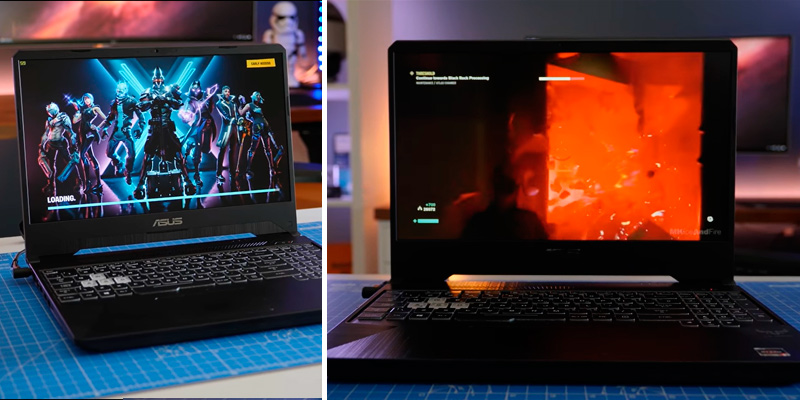
Additional Info
| Last updated price | $979.00 |
| Stock | In stock |
| ASIN | B07VCNTRG6 |

Lenovo Ideapad L340 (81LK00HDUS)
Taming the Hottest Titles
The Lenovo Ideapad L340 is as much about gaming as it is about seamless aesthetics, facilitating productivity and bridging the gap between you and the laptop. Still, costing around $800, the model has its limitations, this is not something that you can avoid keeping the price tag this low. First, the speakers are not great. Second, the GPU, even though pretty good relative to its cost, is nothing to write home about.
The card manages somewhere around 40 fps running the most recent Assassin's Creed iteration, nothing to scoff yet but also nothing to parade. Games like Battlefield 1 and Crysis 3, even though absolute beasts, will not be dipping below 60 fps because these games have been optimized. But those titles that have not received optimization efforts and those that have ludicrous ultra presets (not unlike the latest Tomb Raider and Ghost Recon installments) will prove a little too challenging, usually dropping the frame rates to ~30 fps. All that being said, generally speaking, the laptop does alright taming the hottest titles, even though some occasional assistance is required.
Again though, despite its gaming disposition, this laptop is an excellent mobile workstation too. Flicking between Quick and Quiet modes, the laptop will let you change both its look and feel, so you'll know when it is time to start working and when some rest is due. The 720p webcam will enable seamless video calls, while the physical shutter on this 'cam will keep private things private, so you do not have to worry about someone hacking the system and spying on you Black Mirror-style.
Working and playing in front of a screen puts its toll on your eyes. With the company's Vantage Eye Care mode, reducing blue light emission as well as adjusting the screen's tone, you can minimize eye strain and fatigue, working and gaming as long as necessary.
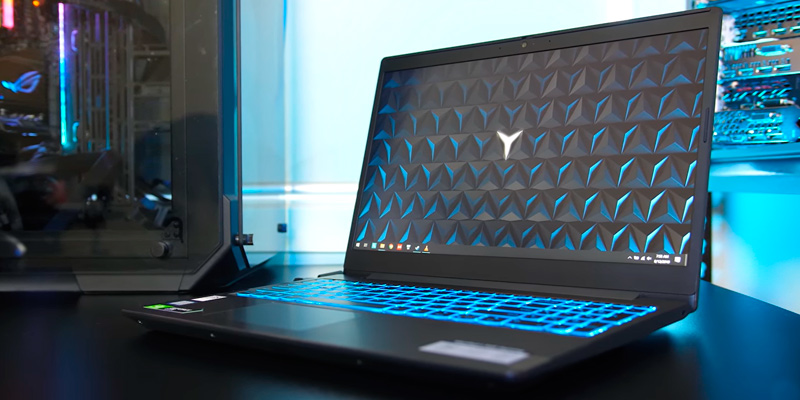
Capable of Heavy Lifting
Besides the above-mentioned GPU, not unlike all computers, the laptop's also packing a processing unit. In this case, it is Intel® Core™ i5-9300H, not the best streaming and multitasking specialist but an excellent gaming piece. To add more, the CPU offers great single-threaded performance, so you can assign this unit some heavy lifting, from compiling programs to 3D rendering and video encoding. The RAM capacity stops at 8 GB, what you usually expect from budget gaming laptops, whereas the SSD has been expanded, offering 512 GB, which lends enough storage space for a decent gaming library.
In short, work hard and play hard, the Lenovo Ideapad L340 will support, sustain, and facilitate that. This is a laptop that knows its worth, delivering across the board (except the audio board).
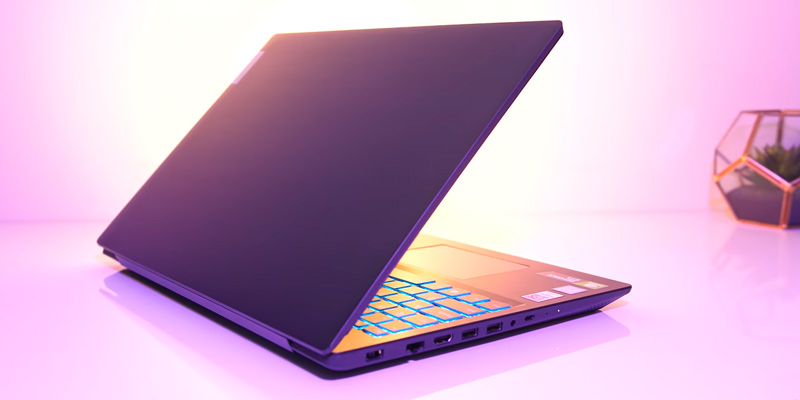
Additional Info
| Last updated price | $749.00 |
| Stock | In stock |
| ASIN | B07VC55LF5 |

HP (17-ca)
Close Enough
As much as we usually like HP laptops, this mobile machine leaves mixed feelings. Because we're reviewing laptops here from the gaming perspective first and foremost, this is not the best value gaming system we could find. No, this laptop is more well-balanced than most, offering comfortable gaming and working alike but, keeping the price tag this modest also means that you're making considerable compromises, at least on the gaming front, with the biggest compromise being the AMD Radeon Vega 8 GPU. Yes, this is an integrated graphics card, something that usually tells you that the system cannot run more demanding games, though this is not quite the case here.
While still an integrated card, with integrated GPUs' limitations, this is one tough hardware piece, usually giving you around 35-40 fps even in the hottest titles, provided you're willing to send the graphics settings down three pegs, choosing between low and medium presets. Sure, the games will not be looking great, but you'd be playing even the most recent titles like Escape from Tarkov, Doom Eternal, Hunt Showdown, NFS Heat, CoD Modern Warfare 2019, Borderlands 3, and more, all hovering somewhere around 35 fps, which is more than acceptable at this price.
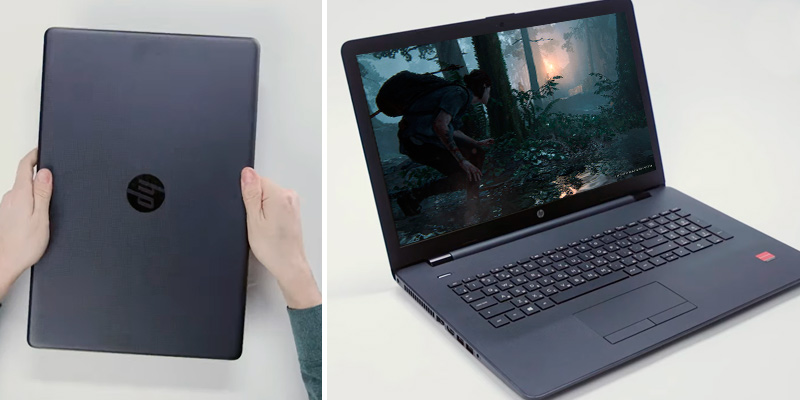
Solid Workstation
Again, this laptop has somewhat sacrificed its GPU, a little unfortunate, but what we have lost there, we have gained almost twofold on the CPU and RAM front. First, we have the AMD® Ryzen™ 5 3500U processing unit, easily landing among the best processors within its price bracket, with its 3.7 GHz boost. Then, we have the 12 GB RAM setup, enabling seamless multitasking. With these two, you'll be managing large databases, complex spreadsheets, compiling programs, rendering 3D models (the GPU might bottleneck these endeavors at times though), mine data, run compression and decompression algorithms, encode video, and more.
These tasks will not only be possible but encouraged by the laptop's 17.3-inch screen. Now, with the display's HD+ (1600 x 900p) native resolution, the picture will not be quite matching Full HD quality, but the increased screen real-estate will aid and facilitate productivity much more than 15-inch screens.
Bottom line, this laptop from HD is not the best gaming machine but, with its great RAM setup, solid CPU, and large screen, this is one considerable workstation that can also run most games, even though not at the highest settings.
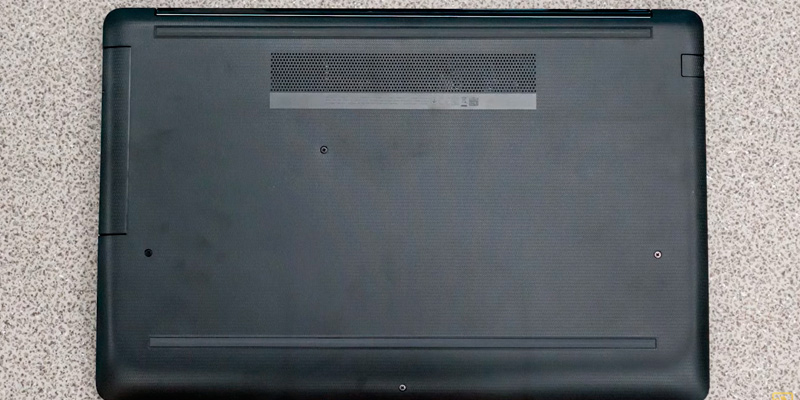
Additional Info
| Last updated price | $748.95 |
| Stock | In stock |
| ASIN | B082NZX92C |
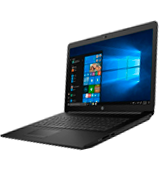
ASUS (TUF-FX505DT)
Making the Right Decisions
The ASUS TUF FX505DT is as good at epitomizing value gaming laptops as its more expensive relative above, except that this one takes the value part at face value (pardon the pun), coming at less than $800. Because the price has been reduced, the specs have been reduced too, although the biggest, most important contributors have remained.
First (and one would argue foremost), the people behind the laptop have replaced the 512 GB SSD with the one that caps at 256 GB, an understandable decision considering that storage space does not affect the frame rate, not at all. Still, when you take into account that games these das usually weigh around ~30 GB and, at times, even above 50, you can see why some people might find the 256 GB setup a little underwhelming.
The CPU has been replaced too, trading the excellent Intel® Core™ i7-9750H for the hard-working AMD® Ryzen™ 5 R5-3550H. Again, we can see where the folk at ASUS were coming from since the former CPU offers comparable frame rates to the latter as far as most titles are concerned and the difference between the two becomes apparent only when you start streaming or executing tasks that very nothing or very little to do with gaming. Long story short, this CPU (the Ryzen one) will not bottleneck the graphics card and even usually pull its weight when you start running more CPU-intensive games (most MMOs, some shooters, some sandboxes, most strategy games).
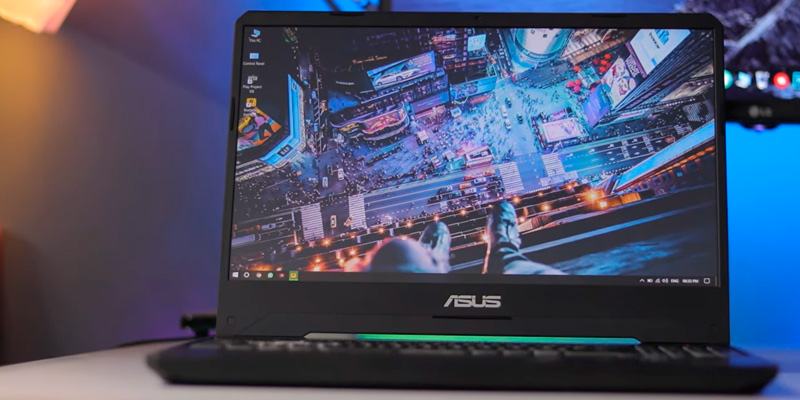
Squeezing Those Juicy 60 FPS
GPU is what defines gaming laptops and, not raising the price tag above $800 and outfitting the system with a card like GeForce GTX 1650 is an impressive feat, so kudos to those who have managed this feat. We have already described this card before, at great length mind you, so all we'll say here is that this graphics card will not let even the greediest, heaviest, most gluttonous AAA titles bully it, squeezing above 60 fps from them even without settling for anything less than ultra graphics settings at the screen's native Full HD (1920 x 1080p) resolution.
What else can we add here? Sure, the touchpad is not very responsive, something that gaming systems should not even care about. What gaming systems should care about though is the company's anti-dust cooling tech, making sure that the laptop can handle heavy loads without overheating.
Summing up, value gaming laptops do not get better than the ASUS TUF FX505DT without going above $800, so assuming that you have the reasonable dough amount, this is the model to go for.
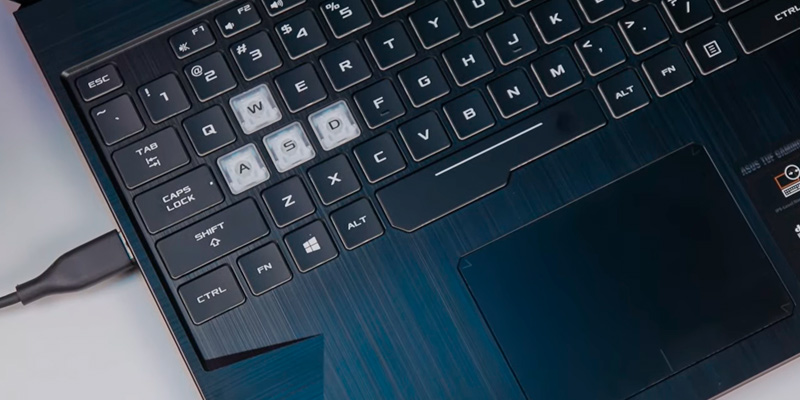
Additional Info
| Last updated price | $888.00 |
| Stock | In stock |
| ASIN | B07VBK4SYS |
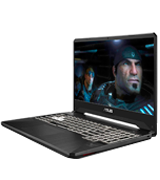
Acer Swift 3 (SF315-41G-R6MP)
The Capable One Within its Gang
The Acer Swift 3 is pretty swift, we will give the engineers/marketers behind this product that much. That being said, you have to put its price into perspective first since "swift" under 700 bucks and "swift" at 1000+ bucks are two separate issues. No, this mobile machine cannot compete with value gaming models that cost around and above 1000 bucks, not the biggest surprise since we're talking about two separate price brackets here.
Within its cheap price bracket, this is one capable system, starting with the 256 GB SSD setup. More often than not, budget laptops (and 650 bucks is as budget as they get, we can tell you that much) come equipped with HDDs, meaning more storage space, sure, but also meaning loading times that can put you to sleep. Using the solid-state drive, this model boots the operating system within ~5-6 seconds and, even though the exact numbers will depend on the app, somewhere around that time to boot most games and programs too.
While seldom as impressive as the more expensive models, budget gaming laptops are still gaming laptops, so it is the graphics card that defines the device's worth. Here, we're greeted by AMD Radeon RX 540, probably the most capable GPU within its class. The issue with this one is that its random-access memory is capped at 2 GB, which means that the card does not quite support the laptop's native Full HD (1920 x 1080p) resolution. No, most games start demanding somewhere around 3-4 GB around that resolution. But, provided you don't mind dialing the resolution down, the game will ensure fantastic performances at HD (1280 x 720p), running most games, from Battlefield V and The Division 2 to Monster Hunter World and the latest Tomb Raider, at around 30-50 fps, depending on the graphics settings and the title's optimization.
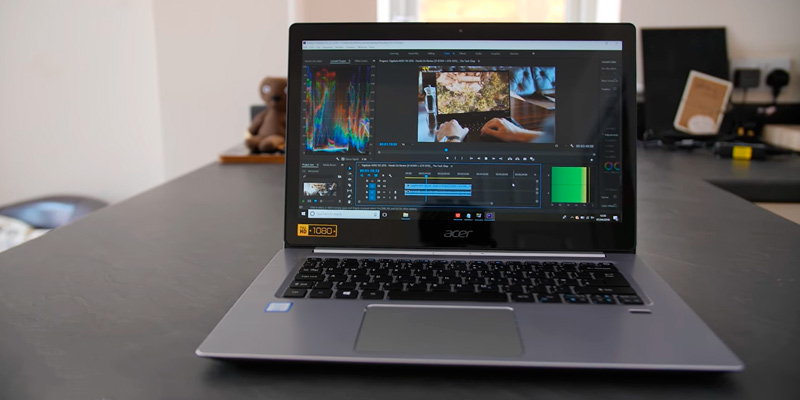
Sleek All-Metal Body
This is an affordable laptop, so we were not expecting much appearance-wise. Nevertheless, the model managed to surprise us, with its thin, sleek, lightweight all-metal body that always remains cool to the touch and the IPS screen that boasts excellent viewing angles (178 degrees), high contrast ratio, and colors that look accurate and not washed-out even when the ambient light surrounding the screen is quite ample.
The laptop comes equipped without a LAN port, a little odd considering that there's enough space there next to the USB ports but, alas, it was not meant to be.
All things considered, the Acer Swift 3 will not disappoint customers with reasonable expectations who understand what they can get paying around 650 bucks.
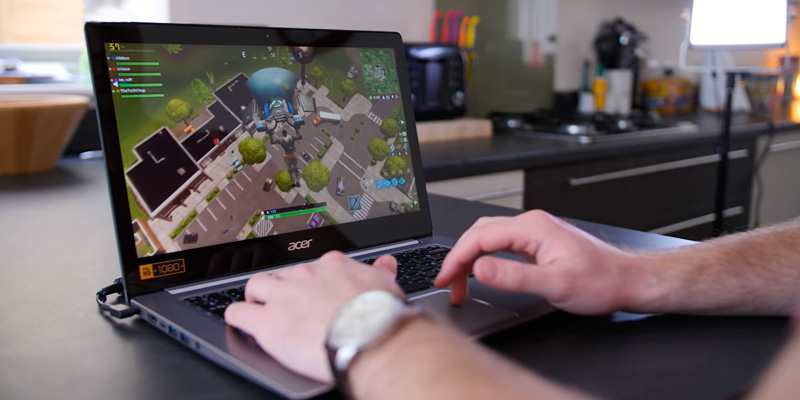
Additional Info
| Last updated price | $849.99 |
| Stock | In stock |
| ASIN | B07GDYNK3B |

What Are Value Gaming Laptops?
Gaming can be an expensive hobby, most will agree on this point. Gaming rigs can cost upwards of 5,000 bucks, gaming peripherals can rival professional recording equipment, and gaming chairs usually have comparable price tags with the most expensive ergonomic chairs. Having said that, you can still play games without paying through the nose, you just have to be smart about it. This is where value gaming laptops are coming to the rescue.
Using these laptops, you can usually play the most system-intensive titles without frying the hardware. Dumping components that do not increase the frame rate, these mobile computers are able to handle the most demanding games, all while costing under 1000 bucks. Still, despite the strict gaming disposition, these are usually solid all-around machines anyway, compact (somewhere around 14 x 10 x 1 inches), lightweight (around 5 pounds), and with considerable batteries (lasting somewhere between 5 and 10 hours depending on the activity). When you're done playing the game, these laptops enable productive work, multimedia consumption, comfortable everyday browsing, and more.
What Features to Compare
GPU
Value gaming laptops are all about squeezing as much frame rates as possible from the least expensive systems, which means that these systems cannot exist without spending more on the graphics card than anything else. Without the right GPU, you can have the most expensive processing unit, more RAM than you can shake a stick at, and as much storage space as you want and the laptop will still not run even middling games, let alone the more demanding ones. We have already covered what the graphics card does and what the CPU and GPU contribute towards the gaming cause in the all-in-one touchscreen computers' review, so we will not be diving deep into the subject here. All you need to know is that you cannot skimp on the GPU, no sir, no bueno, no can do.
CPU
Again, where the gaming subject is concerned, we have already outlined the processing unit's purpose and necessity when reviewing AIO touchscreen systems, so we're moving along here. As long as you understand that the CPU matters almost as much as the GPU and read these reviews, you can make the right choice.
RAM
Normally, you cannot go wrong with more random-access memory, but gaming systems do not benefit from excess RAM, not really. Most games these days consume somewhere around 6 GB, meaning that going above 8 GB seldom makes much sense unless you are planning on running countless chrome tabs and edition videos in the background while playing the hottest games.
Storage
Even the more affordable laptops nowadays are ditching HDDs and come equipped with SSDs, usually offering less storage space, which's unfortunate, sure, but SSDs are also reducing the loading times ~threefold, so you can see why HDDs are becoming obsolete. Pairing the two is where the sweet spot lies but value gaming builds seldom have the budget to do so.
Display
When you're talking about computers, screens are as important as the hardware, no one can claim otherwise. But, when you're talking about value gaming laptops, you're usually talking about something more specific, something along IPs panels' lines and something that can refresh somewhere between 60 and 144 times per second.
Interfaces
This is where the difference between models from competing companies is, more often than not, practically nonexistent. Both expensive laptops and budget systems are usually featuring the same HDMI input, 3-4 USB ports, LAN port, and the standard 3.5mm jack, sometimes adding maybe an SD card slot to the mix, maybe a DVD-RW drive.
Graphics Settings
Even the biggest, most seasoned gamers that have spent the last 15+ years tweaking the same settings seldom understand what these settings mean, at least above surface-level stuff. Can we blame them? Not, not really. Games are supposed to be fun, they're not supposed to be extensive lectures regarding resolution, refresh rate, textures, scaling, anti-aliasing, anisotropic filtering, post-processing, tesselation, synchronization, dynamic range, bloom, ambient occlusion, we're just beginning. Still, understanding the basics will not hurt, right? Sure, when you have the option, cranking them all up feels satisfying but value gaming laptops seldom give you that option, so you can benefit from learning a little about these settings.
Resolution
This is easy and most people already know at least something regarding this subject. Without going into obscure details, the display resolution is the pixel amount that's present on the screen at the same time. Generally speaking, more equals better here, but not always, not quite. See, you can fit almost as many pixels into almost any screen as you want but seeing the difference between ~2,000 and 4,000 pixels (width) on 15-inch screens without even mentioning the added ~1000-2000 pixels (length) is no easy task. Hence, most laptop screens are not going above Full HD (1920 x 1080p). These are the screens' native resolution though and you can always change the game's resolution despite what the screen's is, though we would not recommend making drastic changes (going from Full HD to HD is fine but anything less than that will start looking blocky and blurry).
Refresh Rate
Again, most people that know something about computers know that refresh rate is the number of unique images that the screen can display. Sometimes, the graphics card can produce more than 60 fps but when the screen's refresh rate is limited to 60 Hz, these frames will be wasted. Also, again, screens have native refresh rates but games let you change that, so, while the screen enables twice that, you can have the game refreshing 60 times per second, matching the in-game frame rate.
Texture Quality
Textures are the skins that sit atop basic blocks that inhabit the 3D environment. When you increase the texture quality, the in-game world (including the backgrounds, characters, everything that is happening on the screen) starts looking more detailed, so you're not seeing blocks, you're seeing realistic units and objects. When you decrease the quality, everything starts looking smudged and pointy. This is the same with more intricate settings like shadows and shaders.
Anti-Aliasing
Aliasing is what happens when low-res images are producing pixelated lines and curves because the in-game engine is always using square pixels, turning them into rounded, realistic-looking objects afterward. Anti-aliasing tech injects comparable blocks around these lines and curves, reducing blockiness and making the visuals look smooth.
Tessellation
Tessellation contributes towards an opposing cause. Since in-game textures are, technically speaking, quads, meaning polygonal shapes made from triangles forming the objects' shape, tessellation lets the GPU repeat these quads multiple times over different surfaces, with these repeated patterns enabling texture displacement that creates bumps in landscapes, reproducing realistic bricks, stones, etc.
Ambient Occlusion and Anisotropic Filtering
These are complicated matters but, unless you're planning on switching careers and joining game designers' ranks, what you need to know is that ambient occlusion is responsible for creating realistic shadow transitions and anisotropic filtering is there to enable smooth transitions from high-quality textures surrounding the character to low-quality textures farther away.
How to:
Popular Comparisons
































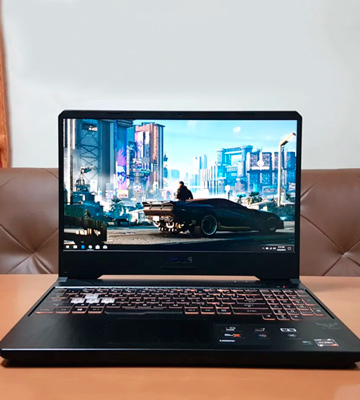
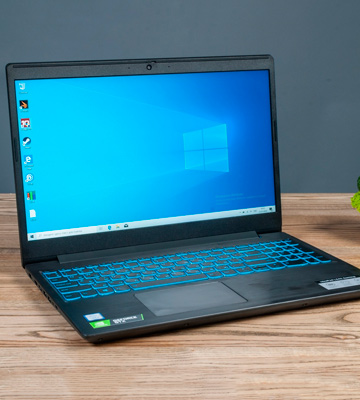
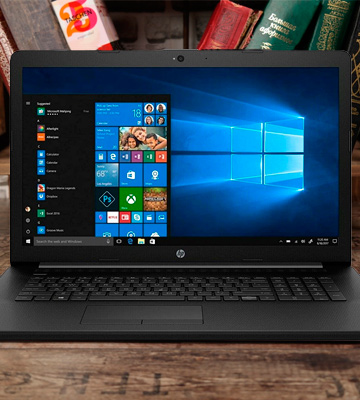
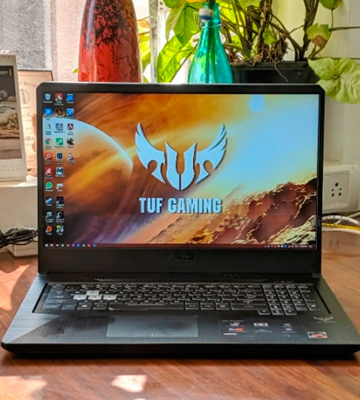
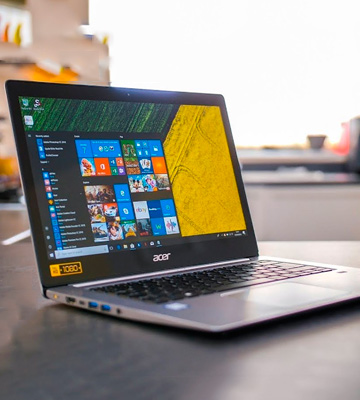
Your comment was successfully sent
Error! Please try again later